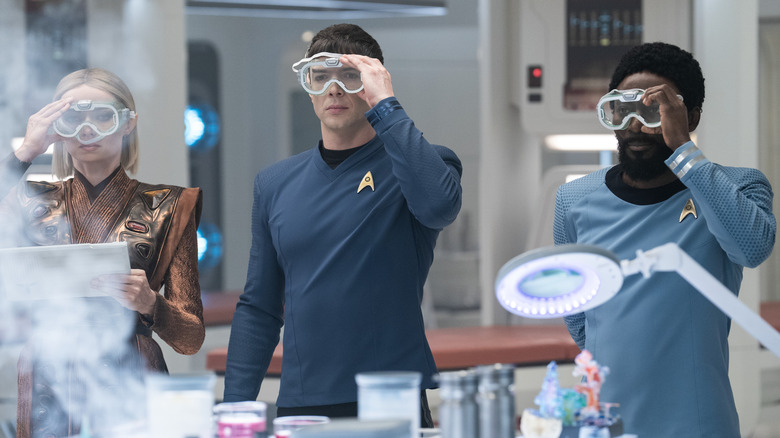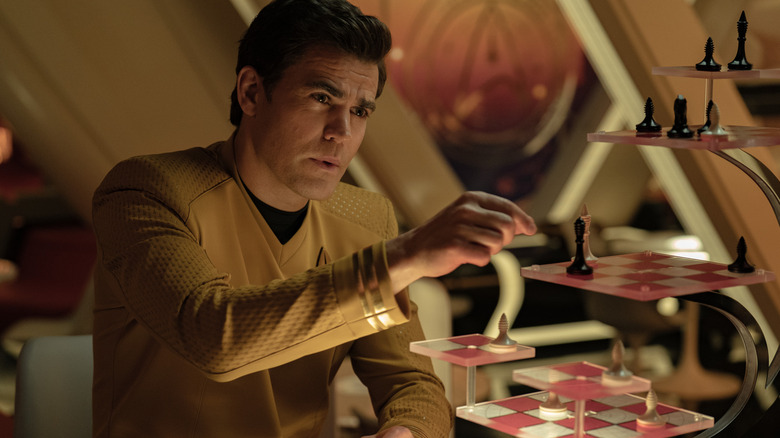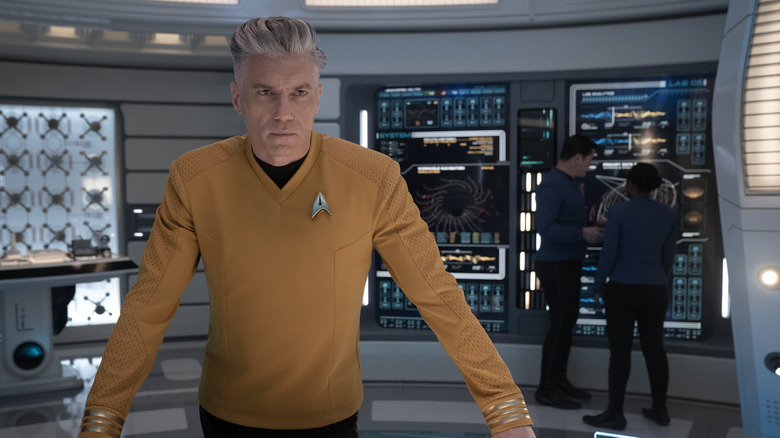This Star Trek TV Series Is The Best Entry Point To The Franchise
To an outsider, "Star Trek" can likely seem quite daunting. The first episode of the original "Star Trek" show debuted nearly 60 years ago, and there have been hundreds and hundreds of TV episodes — not to mention 14 feature films — in the ensuing decades. Most casual pop culture enthusiasts may know that Gene Roddenberry's 1966 "Star Trek" is set in the 23rd century, and that follow-up series "The Next Generation" is set in the 24th, but after that, the complex timeline of "Star Trek" becomes a little hazy. Then, starting in 2009, audiences had to concern themselves with a proper "Star Trek" reboot (in the form of J.J. Abrams' "Star Trek" feature film) that introduced parallel timelines as well.
The waters were muddied even further in 2017, when CBS All Access (later Paramount+) launched a slew of new "Star Trek" shows, each one set along a different point in the franchise's timeline. "Star Trek: Discovery" was a prequel to the original "Star Trek," while "Star Trek: Picard" took place after the events of "Star Trek: Voyager," etc. etc. etc. And the hits kept coming. As of this writing, there have been 15 separate "Star Trek" shows (provided one counts "Short Treks" and "Very Short Treks" as separate series). Many might not even be aware of some of the newer "Star Trek" shows, turning the franchise into a large, shapeless blob of content.
So if one wants to get into "Star Trek," where do they even begin? The logical choice is to begin with the first episode of the original series, of course, but that may not be a universal entry point. Many younger viewers may find "Star Trek" a little daunting, and impatient viewers may not like the 1966 show's pacing or sexism.
Perhaps, then, start with something a little lighter. One wouldn't do poorly to begin with "Star Trek: Strange New Worlds."
Strange New Worlds is a friendly entry point for Star Trek newcomers
Again, the logical starting point for an undertaking like this is "Star Trek: The Original Series." However, this article is directed at people who aren't intimately familiar with "Star Trek," and for them, the original series may ironically be too familiar. "Star Trek" has become so pervasive throughout popular culture, it's entirely likely neophytes have seen episodes of the original series, or even one of the first six feature films, without even trying. Idle afternoons on SyFy may have brought "The Trouble with Tribbles" or "Where No Man Has Gone Before" in front of people's eyeballs, and if those idle afternoons didn't convert a curious seeker, then additional episodes of the same show won't either.
Indeed, the iconography, catchphrases, and characters of the original "Star Trek" are so pervasive in the pop subconscious, one no longer needs to learn the basics. They're practically Jungian archetypes by now. Abrams' 2009 film was expressly made for those only familiar with icons and catchphrases. Revisiting the original series won't teach many people what they don't already know.
No, perhaps it's better to start with newer Trek shows, which are a totally different animal from the classic (that is: pre-2005) Treks. "Star Trek: Strange New Worlds" debuted in 2022 on Paramount+, and served as a direct prequel to the original "Star Trek." The series has a lot of the same characters as the original "Trek," but slightly younger, as the show takes place less than a decade before the 1966 show. It's the same U.S.S. Enterprise, and Spock (Ethan Peck) is on board. Uhura (Celia Rose-Gooding) is also there, as are other legacy characters like Nurse Chapel (Jess Bush) and Dr. M'Benga (Babs Olusanmokun).
But the show is made with modern pacing, modern cameras, and modern SFX. It's a way to explore neighboring "Star Trek" material, while still safe in the arms of a 2020s filmmaking style.
Strange New Worlds is light and casual
Some neophytes may also complain that "Star Trek," generally speaking, is a little too formal and stodgy for a mainstream audience, and that's a fair complaint. "Star Trek" isn't predicated on outsize emotions and action, but professional relationships, military propriety, and complex technical jargon. Compared to, say, "Star Wars," "Star Trek" can be headier, more philosophical, and definitely downbeat. That, of course, is why many of us Trekkies like it, but those are difficult selling points when talking to a n00b.
"Strange New Worlds," like most of the newer "Star Trek" shows, features more action, including several episodes that boast multiple fistfights and phaser battles. It's not excessively violent or weirdly oblique like "Star Trek: Discovery," though. It's slicker and easier to consume.
Moreso, though, "Strange New Worlds" is a light, humorous show. About a quarter of the episodes are straightforward comedies, and the characters are, for the most part, smiling, happy, and glad to be working. The dark, intense episodes are an aberration. In this series, Spock is more human and expressive, even going so far as to laugh, fall in love, and become openly annoyed. This is a series that cannot abide by emotionlessness. Captain Pike (Anson Mount) is such an affable character, he regularly cooks for his crew. "Strange New Worlds" is by far the friendliest "Star Trek."
Most importantly, though, "Strange New Worlds" is episodic. Unlike "Discovery" or "Picard," one doesn't need to commit to entire seasons to understand a story. "Strange New Worlds" concludes at the end of every episode, making it easily consumed in bite size portions. The episodic nature is also reminiscent of classic "Trek," allowing naive folks to better picture the original series without having to butt heads with it.
Results may vary, of course. If a friend starts you on season 4 of "Next Generation," for instance, you won't be hurting. But "Strange New Worlds" is a good gateway into the vast cosmos of "Star Trek."


